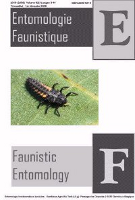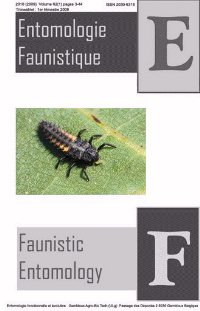- Accueil
- Volume 76 (2023)
- Description of two new species of Leinendera Carrera 1945 from Brazil (Diptera, Asilidae, Asilinae)
Visualisation(s): 2659 (35 ULiège)
Téléchargement(s): 40 (0 ULiège)
Description of two new species of Leinendera Carrera 1945 from Brazil (Diptera, Asilidae, Asilinae)

Document(s) associé(s)
Version PDF originaleRésumé
Deux nouvelles espèces du genre Leinendera Carrera 1945 sont décrites, en provenance du Brésil : L. lusitania sp. nov. et L. francisii sp. nov. L’habitus, les ailes ainsi que les genitalia mâles sont décrits et illustrés. Une clé dichotomique permettant d’identifier les 7 espèces du genre Leinendera est fournie.
Abstract
Two new species of genus Leinendera Carrera 1945 from Brazil, L. lusitania sp. nov. and L. francisii sp. nov., are described. The habitus, wing and male terminalia are described and illustrated. An identification key for the seven Leinendera species is provided.
Table des matières
UUID : https://zoobank.org/5527E14C-3906-4006-8204-39584C87B4A3
Reçu le 7 octobre 2022, accepté le 16 décembre 2022
INTRODUCTION
1This work is a continuation of studies on Asilidae kept at the conservatoire of Gembloux Agro-Bio Tech (ULiège, Belgium) (Tomasovic & Braet, 2001 ; Tomasovic, 2002 ; Tomasovic, 2013a ; Tomasovic, 2013b ; Tomasovic, 2014 ; Tomasovic, 2020). Asilinae is the most diverse subfamily in the bosom of Asilidae from Neotropical region with about 68 geni (Camargo et al., 2016) and more than 550 species. In the present work, two new species of genus Leinendera Carrera 1945 from South-east Brazil are described and illustrated. A key to species is provided.
MATERIAL AND METHODS
2Our four males of genus Leinendera come from a batch graciously donated by Dr. Claire Villemant (Hymenoptera : Museum national d’Histoire naturelle, Paris, France). They were captured during a sampling campaign in the period of 23-30 September 2000 in the nature reserve of Linhares, area of 220 km2 on the coast of Brazil.
3The male genitalia were dissected and glued on a cardboard attached to the pin of the corresponding specimen. The photographs were taken by J. Mignon with a Canon 90d equipped with a Canon EF 100 mm f/2,8L Macro IS USM. The focus bracketing function was used and the image was compiled by stacking with the DPP 4.10 software. For morphological terminology we have followed Geller-Grimm (2007).
SYSTEMATIC
Genus Leinendera Carrera 1945
4Carrera (1945) found the genus Leinendera with the species L. rubra. He found similarities in habitus to Glaphyropyga Shiner 1866. The species L. rubra is retained in the catalogue of Neotropical Asilidae by Papavero (2008). In the key to Neotropical Asilinae, Papavero et al. (2009) placed Leinendera in the species with anatergite pilose and marginal scutellar bristles absence. Camargo et al. (2019) have given the history of the genus as well as a key to the five known species, all from Brazil. They cited three species with marginal scutellar bristles absence, L. achaeta Camargo, Veira, Köhler & Rafael 2016, L. carrerai Camargo, Vieira & Rafael 2019 and L. mnrj Camargo, Vieira & Rafael 2019, but also two species with marginal scutellar bristles presence L. rubra Carrera 1945 and L. nigra Vieira 2012.
5Leinendera lusitania sp. nov. (Figs. 1-3)
6Etymology. Lusitania = in reference to ancient Brazilian name.
7UUID: https://zoobank.org/0451C540-C36B-4B95-A531-D39D92F5D98F
8Type material
9Holotype: 1 ♂, 15-22.xi.2000, Brésil, Espinito Santo, fragment «Mun Sooretama», S.19°11’ W40°06’, forêt semi-décidue, 36 km NNE Linhares, rec. Grandcolas, Pellens.
10Paratype: 1 ♂ same as holotype.
11Diagnosis. Face narrow. Pospedicel black, lanceolate with small yellow mark at the lower part, about the same length as the scape; style black and long about the same length as the scape, pedicel and postpedicel together. Mesonotum brown with a central dark strip, setae black. Legs yellow. Abdomen dark, tergites with clear marginal and lateral strip and fines white setae. Genitalia dark or brown.
12Description
13Male holotype (Figs. 1, 2)
14Face. Narrow with white tomentum, mystax bushy with white setae and a few fine and black setae above. Antenna, scape and pedicel yellow with black setae, scape two time longer than the pedicel, postpedicel black, lanceolate with small yellow mark at the lower part, about the same length as the scape, style black, long about the same length as the scape, pedicel and postpedicel together. Frons with brown tomentum. Palpus black with long, fine and black setae. Proboscis black with ventral and white setae. Occiput white tomentum and with black postocular bristles.
15Thorax. Antepronotum and postpronotum with greyish tomentum and white fine setae, scutum dark brown dorsally and brown laterally and with sparse fine and black setae, scutellum brown, the ring with grey tomentum. Chaetotaxy, bristles black: 2 notopleural, 2 supra-alar, 2 postalar, 8 pairs of dorsocentral, 2 scutellar. Pleura brown with grey tomentum, anepisternum, proepimeron, katepisternum darker, katatergal and metepisternal with longs and fines setae, anatergal hairs black.
 Figure 1: Leinendera lusitania sp. nov., male. Habitus, lateral view.
Figure 1: Leinendera lusitania sp. nov., male. Habitus, lateral view.
 Figure 2: Leinendera lusitania sp. nov., male. Habitus, dorsal view
Figure 2: Leinendera lusitania sp. nov., male. Habitus, dorsal view
16Wings. Clear with brown veins microtrichia lighten on the wing apex with small brown patch. Cross vein r-m passes below middle of discal cell. Halter pale yellow.
17Legs. Coxae with grey tomentum and white setae. Femora, tibia and tarsi yellowish. Femora with some short black setae and very fines and longs white setae on the ventral part. Tibias with longs and fines black setae, shooter and stout to apex. Tarsomeres with black bristles, the 1st tarsomere long.
18Abdomen. Tergites with a white strip on posterior and lateral margin, short discal black setae on the centre they are laterally more longer and white and black. Sternites black with white posterior margin, and long and fine black or white setae.
19Male genitalia. (Fig. 3) Black. Epandrium elongate, broader in the apical part with rounded apex, dorsal margin with numerous small denticles on the half posterior apex. Gonocoxites short, triangular with rounded apex, dististylus slender curved, widening apically with an apical corner. Aedeagal sheat subtriangular in lateral view endophallus very short. Apodeme slender.
20Female. Unknown.

Figure 3: Leinendera lusitania sp. nov., male. Genitalia.
21Leinendera francisii sp. nov. (Figs. 4-6)
22UUID: https://zoobank.org/d49ec698-d644-4635-b216-ffcd27b91d1c
23Etymology. In gratitude to Prof. F. Francis, University of Liège, Gembloux Agro-Bio Tech, Functional and Evolutionary Entomology, foundator of Hexapoda Museum in the city of Waremme, dedicated for its entire engagement to entomology.
24Type material.
25Holotype: 1 ♂, Brésil, Espinito Santo, Res. de Linhares, CVRD, 40 km NNE Linhares, S.19°08’ W40°03’, Forêt semi-décidue, 15-20.iv.2000
26Paratype: 1 ♂ same as holotype.
27Diagnosis. Face narrow. Postpedicel brown, lanceolate with small yellow mark at the lower part, shorter than the scape ; style black longer than the scape, pedicel and postpedicel together. Mesonotum central darker, greyish laterally, setae black. Legs yellow. Abdomen grey brown, with yellowish chaetotaxy, tergites pale. Genitalia dark or brown.
 Figure 4: Leinendera francisii sp. nov., male. Habitus, lateral view.
Figure 4: Leinendera francisii sp. nov., male. Habitus, lateral view.

Figure 5: Leinendera francisii sp. nov., male. Habitus, dorsal view.
28Description
29Male holotype. (Figs. 4, 5)
30Head. Face and frons narrow with white tomentum, mystax not condensed with fine and long white setae. Antenna, scape and pedicel yellow with black setae, scape two time longer than pedicel, postpedicel brown, lanceolate with small yellow mark at lower part, shorter than the scape, style black, longer than the scape, pedicel and postpedicel together. Palpus brown with long, fine and white setae. Proboscis black with white setae to the ventral part and to apex. Occiput with white tomentum and with white postocular bristles.
31Thorax. Antepronotum and pospronotum with greyish tomentum and white fine setae, scutum greyish with a brown stripe on the middle, scutellum grey. Chaetotaxy, bristles long, fine and black: 2 notopleural, 2 supra-alar, 2 postalar, 6 pairs of dorsocentral, 2 scutellar. Pleura with grey tomentum, katatergal and metepisternal setae long and fine, black anatergal hairs.
32Wings. Hyaline with brown veins and with dense microtrichia at wing apex, 4th radial cell narrow, cross vein r-m passes below middle of discal cell. Halter, pale, whitish knop, with brown strip laterally.
33Legs. Yellowish. Coxae with grey tomentum and white setae. Femora I-II with long, fine and yellowish setae on the ventral part, on the III they are black. Tibias with yellow bristles to apex, tibias I-II with long and fine yellowish setae, on the III they are black. Tarsomeres with black bristles, the 1st tarsomere long.
34Abdomen. Tergites brown with grey margin, covered by very short, fine, yellow setae, and some long, fine and yellow setae laterally. Sternites grey-yellowish with fine, long and white setae.
35Male genitalia. (Fig. 6) Black. Epandrium elongate, with rounded apex, the dorsal margin with numerous stout distinct denticles. Gonocoxites short, triangular, dististylus slender curved with long pointed apex. Aedeagal sheath short, very wide, and large, rounded, dorsal apical processes above the very short endophallus. Apodeme slender.
36Female. Unknown

Figure 6: Leinendera francisii sp. nov., male. Genitalia.

DISCUSSION
37The seven species of Leinendera are located in narrow strip dense of coastal semi-deciduous rainforest over 3000 km on Brazil's Atlantic coast between Natal and Rio Grande (Huetz de Lemps, 1994, p. 141, fig. 65).
38We find that the genus has a fairly homogeneous habitus but nevertheless shows some differences both in their morphologies and in the genitalia. If the aedeagus of L. lusitania is similar to that of L. achaeta, L. carrerai and L. mnrj and in particular reminds us those of Palearctic region for the genus Erax Scopoli 1763 (Theodor, 1980, p. 328, fig. 586), for L. francisii it’s close to the species Satanas gigas (Eversmann 1855) (Theodor, 1976, p. 145, fig. 348).
Bibliographie
Camargo A., Vieira R., Köhler A. & Rafael J., 2016. Leinendera achaeta sp.n., a new species of robber fly from Brazil (Diptera, Asilidae, Asilinae). ZooKeys, 558, 109-118.
Camargo A., Vieira R., Köhler A. & Rafael J., 2019. Revision of Leinendera Carrera, 1945 (Diptera : Asilidae : Asilinae) with description of two new species. Zootaxa, 4657(2), 291-316.
Geller-Grimm F., 2007. Information on Robber Flies, Terminology. http://www.geller-grimm.de
Huetz de Lemps A., 1994. Les paysages végétaux du globe. Initiation aux études de géographie. Paris, Masson, 182 p.
Papavero N., 2008. Catalogue of Neotropical Diptera. Asilidae. Neotropical Diptera 17, 1-178.
Papavero N., Artigas J.N. & Lamas C.J.E., 2009. Manual of Neotropical Diptera. Asilidae. Neotropical Diptera, 18, 1-320.
Theodor O., 1976. On the structure of the spermathecae and aedeagus in the Asilidae and their importance in the systematics of the family. Jerusalem, Israel Academy of Sciences and Humanities.
Theodor O., 1980. Diptera : Asilidae - Fauna Palaestina : Insecta II, Jerusalem, 488 p.
Tomasovic G. & Braet Y., 2001. Description d’une nouvelle espèce de Pseudorus Walker appartenant à un complexe mimétique néotropical (Diptera : Asilidae). Lambillionea, CI(3), 379-385.
Tomasovic G., 2002. Résumé sur la connaissance des Asilidae (Diptera Brachycera) de Guyane française et description de trois espèces nouvelles. Bulletin de la Société royale belge d’Entomologie, 138, 85-90.
Tomasovic G., 2013a. Etude sur l’édéage de mâles appartenant au genre Promachus Loew, 1848 (Diptera : Asilidae) 2. Des régions néartique, néotropical, orientale et paléarctique. Entomologie faunistique - Faunistic Entomology, 66, 3-25.
Tomasovic G., 2013b. Description of Macrocolus villemantae n. sp. from Reserve of Linhares, CVRD (Brazil) (Diptera : Asilidae, Dasypogoninae). Entomologie faunistique - Faunistic Entomology, 66, 61-62.
Tomasovic G., 2014. Les genres Rhopalogaster Macquart 1834, Storthyngomerus Hermann 1919 et Borapisma Hull 1957 (Diptères : Asilidae : Laphriinae : Laphriini), une distribution géographique pour le moins interpellante. Entomologie Faunistique - Faunistic Entomology, 67, 59-63.
Tomasovic G., 2020. Apport à la connaissance des espèces du genre Pseudorus Walker 1851 en Guyane française (Diptera : Asilidae). Entomologie Faunistique - Faunistic Entomology,73, 184-190.
Vieira R., 2012. A new species of Leinendera Carrera, 1945 (Diptera, Asilidae, Asilinae) from Brazil. Biota Neotropica, 12(3), 50-56.
(15 Réf)






